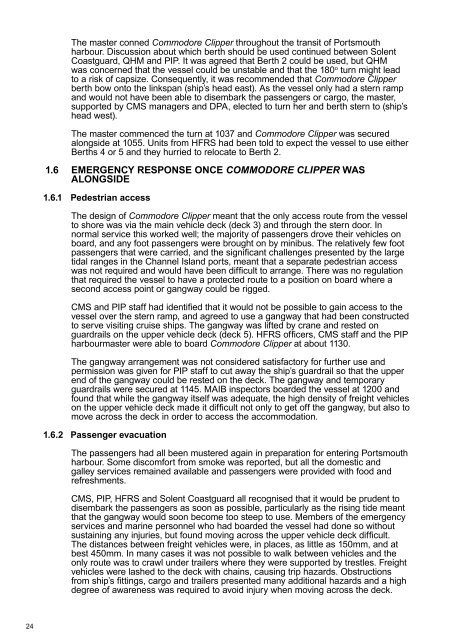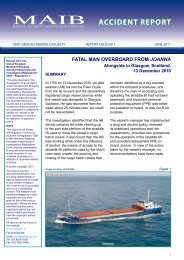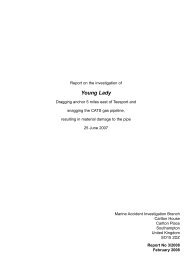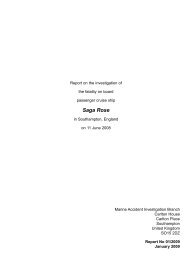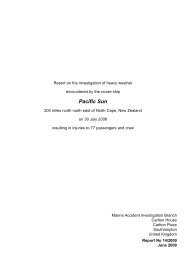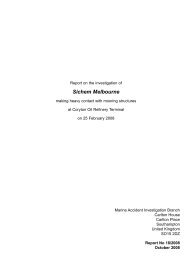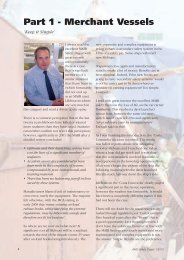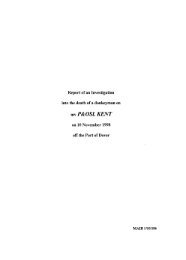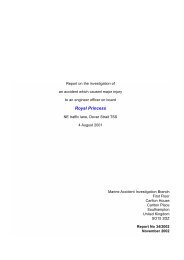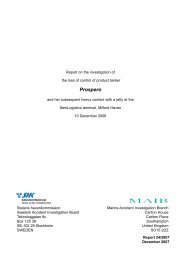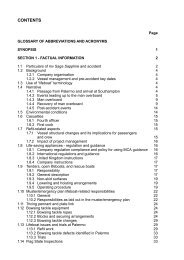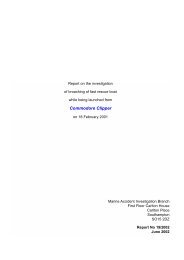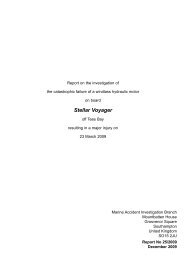Commodore Clipper - Marine Accident Investigation Branch
Commodore Clipper - Marine Accident Investigation Branch
Commodore Clipper - Marine Accident Investigation Branch
Create successful ePaper yourself
Turn your PDF publications into a flip-book with our unique Google optimized e-Paper software.
24<br />
The master conned <strong>Commodore</strong> <strong>Clipper</strong> throughout the transit of Portsmouth<br />
harbour. Discussion about which berth should be used continued between Solent<br />
Coastguard, QHM and PIP. It was agreed that Berth 2 could be used, but QHM<br />
was concerned that the vessel could be unstable and that the 180 o turn might lead<br />
to a risk of capsize. Consequently, it was recommended that <strong>Commodore</strong> <strong>Clipper</strong><br />
berth bow onto the linkspan (ship’s head east). As the vessel only had a stern ramp<br />
and would not have been able to disembark the passengers or cargo, the master,<br />
supported by CMS managers and DPA, elected to turn her and berth stern to (ship’s<br />
head west).<br />
The master commenced the turn at 1037 and <strong>Commodore</strong> <strong>Clipper</strong> was secured<br />
alongside at 1055. Units from HFRS had been told to expect the vessel to use either<br />
Berths 4 or 5 and they hurried to relocate to Berth 2.<br />
1.6 EMERGENCY RESPONSE ONCE <strong>Commodore</strong> <strong>Clipper</strong> wAS<br />
ALONGSIDE<br />
1.6.1 Pedestrian access<br />
The design of <strong>Commodore</strong> <strong>Clipper</strong> meant that the only access route from the vessel<br />
to shore was via the main vehicle deck (deck 3) and through the stern door. In<br />
normal service this worked well; the majority of passengers drove their vehicles on<br />
board, and any foot passengers were brought on by minibus. The relatively few foot<br />
passengers that were carried, and the significant challenges presented by the large<br />
tidal ranges in the Channel Island ports, meant that a separate pedestrian access<br />
was not required and would have been difficult to arrange. There was no regulation<br />
that required the vessel to have a protected route to a position on board where a<br />
second access point or gangway could be rigged.<br />
CMS and PIP staff had identified that it would not be possible to gain access to the<br />
vessel over the stern ramp, and agreed to use a gangway that had been constructed<br />
to serve visiting cruise ships. The gangway was lifted by crane and rested on<br />
guardrails on the upper vehicle deck (deck 5). HFRS officers, CMS staff and the PIP<br />
harbourmaster were able to board <strong>Commodore</strong> <strong>Clipper</strong> at about 1130.<br />
The gangway arrangement was not considered satisfactory for further use and<br />
permission was given for PIP staff to cut away the ship’s guardrail so that the upper<br />
end of the gangway could be rested on the deck. The gangway and temporary<br />
guardrails were secured at 1145. MAIB inspectors boarded the vessel at 1200 and<br />
found that while the gangway itself was adequate, the high density of freight vehicles<br />
on the upper vehicle deck made it difficult not only to get off the gangway, but also to<br />
move across the deck in order to access the accommodation.<br />
1.6.2 Passenger evacuation<br />
The passengers had all been mustered again in preparation for entering Portsmouth<br />
harbour. Some discomfort from smoke was reported, but all the domestic and<br />
galley services remained available and passengers were provided with food and<br />
refreshments.<br />
CMS, PIP, HFRS and Solent Coastguard all recognised that it would be prudent to<br />
disembark the passengers as soon as possible, particularly as the rising tide meant<br />
that the gangway would soon become too steep to use. Members of the emergency<br />
services and marine personnel who had boarded the vessel had done so without<br />
sustaining any injuries, but found moving across the upper vehicle deck difficult.<br />
The distances between freight vehicles were, in places, as little as 150mm, and at<br />
best 450mm. In many cases it was not possible to walk between vehicles and the<br />
only route was to crawl under trailers where they were supported by trestles. Freight<br />
vehicles were lashed to the deck with chains, causing trip hazards. Obstructions<br />
from ship’s fittings, cargo and trailers presented many additional hazards and a high<br />
degree of awareness was required to avoid injury when moving across the deck.


